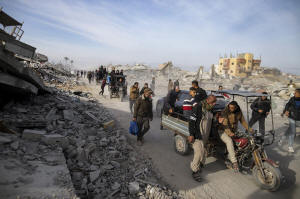Palestinians trek across rubble to return to their homes as Gaza
ceasefire takes hold
 Send a link to a friend
Send a link to a friend
 [January 20, 2025]
By SAMY MAGDY and WAFAA SHURAFA [January 20, 2025]
By SAMY MAGDY and WAFAA SHURAFA
KHAN YOUNIS, Gaza Strip (AP) — Even before the ceasefire deal between
Israel and Hamas was fully in place on Sunday, Palestinians in the
war-battered Gaza Strip began to return to the remains of the homes they
had evacuated during the 15-month war.
Majida Abu Jarad made quick work of packing the contents of her family’s
temporary lodging in the sprawling tent city of Muwasi, just north of
the strip’s southern border with Egypt.
At the start of the war, they were forced to flee their house in Gaza’s
northern town of Beit Hanoun, where they used to gather around the
kitchen table or on the roof on summer evenings amid the scent of roses
and jasmine.
The house from those fond memories is gone, and for the past year, Abu
Jarad, her husband and their six daughters have trekked the length of
the Gaza Strip, following one evacuation order after another by the
Israeli military.
Seven times they fled, she said, and each time, their lives became more
unrecognizable to them as they crowded with strangers to sleep in a
school classroom, searching for water in a vast tent camp or sleeping on
the street.
Now the family is preparing to begin the trek home — or to whatever
remains of it — and to reunite with relatives who remained in the north.
“As soon as they said that the truce would start on Sunday, we started
packing our bags and deciding what we would take, not caring that we
would still be living in tents,” Abu Jarad said.

The war in Gaza began when Hamas-led militants attacked southern Israel
on Oct. 7, 2023, killing some 1,200 people, mostly civilians, and
abducting around 250 people. Some 100 hostages are still inside Gaza, at
least a third of whom are believed to be dead.
The Israeli military bombardment that followed the attack has flattened
large swaths of Gaza and displaced 1.9 million of its 2.3 million
residents.
Over 46,000 Palestinians have been killed, according to Gaza’s Health
Ministry, which says women and children make up more than half the
fatalities but does not distinguish between civilians and fighters. The
Israeli military says it has killed over 17,000 militants, without
providing evidence.
A long walk home through the devastation of Gaza
Even before the ceasefire officially took effect — and as tank shelling
continued overnight and into the morning — many Palestinians began
trekking through the wreckage to reach their homes, some on foot and
others hauling their belongings on donkey carts.
“They’re returning to retrieve their loved ones under the rubble,” said
Mohamed Mahdi, a displaced Palestinian and father of two. He was forced
to leave his three-story home in Gaza City’s southeastern Zaytoun
neighborhood a few months ago.
Mahdi managed to reach his home Sunday morning, walking amid the rubble
from western Gaza. On the road he said he saw the Hamas-run police force
being deployed to the streets in Gaza City, helping people returning to
their homes.
Despite the vast scale of the destruction and uncertain prospects for
rebuilding, “people were celebrating," he said. "They started clearing
the streets and removing the rubble of their homes. It’s a moment
they’ve waited for for 15 months.”
Um Saber, a 48-year-old widow and mother of six, returned to her
hometown of Beit Lahiya. She asked to be identified only by her
honorific, meaning “mother of Saber,” out of safety concerns.
Speaking by phone, she said her family had found bodies in the street as
they trekked home, some of which appeared to have been lying in the open
for weeks.
When they reached Beit Lahiya, they found their home and much of the
surrounding area reduced to rubble, she said. Some families immediately
began digging through the debris in search of missing loved ones. Others
began trying to clear areas where they could set up tents.
[to top of second column]
|

Displaced Palestinians leave parts of Khan Younis as they go back to
their homes in Rafah, southern Gaza Strip, Sunday, Jan. 19, 2025.
(AP Photo/Jehad Alshrafi)

A hospital destroyed
Um Saber said she also found the area's Kamal Adwan Hospital
“completely destroyed.”
“It’s no longer a hospital at all,” she said. "They destroyed
everything.”
The hospital has been hit multiple times by Israeli forces waging an
offensive in largely isolated northern Gaza against Hamas fighters
it says have regrouped.
The military has claimed that Hamas militants operate inside Kamal
Adwan, which hospital officials have denied.
In Gaza’s southern city of Rafah, residents returned to find massive
destruction across the city that was once a hub for displaced
families fleeing Israel’s bombardment elsewhere. Some found human
remains amid the rubble of houses and the streets.
“It’s an indescribable scene. It’s like you see in a Hollywood
horror movie,” said Mohamed Abu Taha, a Rafah resident, speaking to
The Associated Press as he and his brother were inspecting his
family home. “Flattened houses, human remains, skulls and other body
parts, in the street and in the rubble.”
He shared footage of piles of rubble that he said had been his
family’s house. “I want to know how they destroyed our home.”
Taking advantage of the ceasefire
The families' return to their homes comes amid looming uncertainty
about whether the ceasefire deal will bring more than a temporary
halt to the fighting, who will govern the enclave and how it will be
rebuilt.
Not all families will be able to return home immediately. Under the
terms of the deal, returning displaced people will only be able to
cross the Netzarim corridor from south to north beginning seven days
into the ceasefire.
At that point, the agreement says civilians would be allowed to
cross into the north on foot without being searched, while a private
company to be agreed upon by Israel and the mediators would search
vehicles.
“We hope that the ceasefire will continue (and be) permanent, so
that we can return to our homes and our children can return to their
schools,” Rami Nofal, a displaced man from Gaza City, said from his
shelter in the central city of Deir al-Balah.
Those who do return may face a long wait to rebuild their houses.

The United Nations has said that reconstruction could take more than
350 years if Gaza remains under an Israeli blockade. Using satellite
data, the United Nations estimated last month that 69% of the
structures in Gaza have been damaged or destroyed, including more
than 245,000 homes. With over 100 trucks working full time, it would
take more than 15 years just to clear the rubble away.
But for many families, the immediate relief overrode fears about the
future.
“We will remain in a tent, but the difference is that the bleeding
will stop, the fear will stop, and we will sleep reassured,” Abu
Jarad said.
——
Magdy reported from Cairo. Associated Press writer Abby Sewell in
Beirut contributed to this report.
All contents © copyright 2025 Associated Press. All rights reserved |